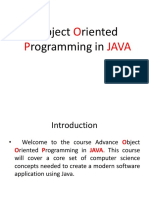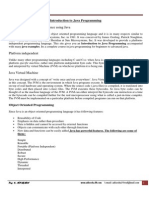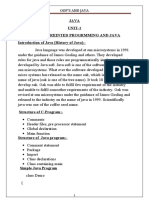Introduction To Java 1
Introduction To Java 1
Uploaded by
swapnilCopyright:
Available Formats
Introduction To Java 1
Introduction To Java 1
Uploaded by
swapnilOriginal Description:
Original Title
Copyright
Available Formats
Share this document
Did you find this document useful?
Is this content inappropriate?
Copyright:
Available Formats
Introduction To Java 1
Introduction To Java 1
Uploaded by
swapnilCopyright:
Available Formats
Topperworld.
in
Introduction to java
Java is a class based high level object oriented programming language
developed by James Gosling in 1995.
Currently It is owned by Oracle, and more than 3 billion devices run Java.
It is used for:
• Mobile applications (specially Android apps)
• Desktop applications
• Web applications
• Web servers and application servers
• Games
• Database connection
• And much, much more!
Features of Java
• Object Oriented − In Java, everything is an Object. Java can be easily
extended since it is based on the Object model.
• Platform Independent − Unlike many other programming languages
including C and C++, when Java is compiled, it is not compiled into
platform specific machine, rather into platform independent byte code.
This byte code is distributed over the web and interpreted by the Virtual
Machine (JVM) on whichever platform it is being run on.
• Simple − Java is designed to be easy to learn. If you understand the
basic concept of OOP Java, it would be easy to master.
• Secure − With Java's secure feature it enables to develop virus-free,
tamper-free systems. Authentication techniques are based on public-key
encryption.
• Architecture-neutral − Java compiler generates an architecture-neutral
object file format, which makes the compiled code executable on many
processors, with the presence of Java runtime system.
• Portable − Being architecture-neutral and having no implementation
dependent aspects of the specification makes Java portable. Compiler in
Java is written in ANSI C with a clean portability boundary, which is a
POSIX subset.
• Robust − Java makes an effort to eliminate error prone situations by
emphasizing mainly on compile time error checking and runtime checking.
• Multithreaded − With Java's multithreaded feature it is possible to write
programs that can perform many tasks simultaneously. This design
feature allows the developers to construct interactive applications that can
run smoothly.
• Interpreted − Java byte code is translated on the fly to native machine
instructions and is not stored anywhere. The development process is more
rapid and analytical since the linking is an incremental and light-weight
process.
• High Performance − With the use of Just-In-Time compilers, Java
enables high performance.
• Distributed − Java is designed for the distributed environment of the
internet.
• Dynamic − Java is considered to be more dynamic than C or C++ since it
is designed to adapt to an evolving environment. Java programs can carry
extensive amount of run-time information that can be used to verify and
resolve accesses to objects on run-time.
First Java Program
Let us look at a simple code that will print the words Hello World.
/* This is my first java program.
* This will print 'Hello World' as the output
*/
public class myFirstJavaClass {
public static void main(String []args) {
System.out.println("Hello World"); // prints Hello World
}
}
OUTPUT
Hello World
About Java programs, it is very important to keep in mind the following points.
• Case Sensitivity − Java is case sensitive, which means
identifier Hello and hello would have different meaning in Java.
• Class Names − For all class names the first letter should be in Upper Case.
If several words are used to form a name of the class, each inner word's
first letter should be in Upper Case.
Example: class MyFirstJavaClass
• Method Names − All method names should start with a Lower Case letter.
If several words are used to form the name of the method, then each inner
word's first letter should be in Upper Case.
Example: public void myMethodName()
• Program File Name − Name of the program file should exactly match the
class name.
When saving the file, you should save it using the class name (Remember
Java is case sensitive) and append '.java' to the end of the name (if the file
name and the class name do not match, your program will not compile).
But please make a note that in case you do not have a public class present
in the file then file name can be different than class name. It is also not
mandatory to have a public class in the file.
Example: Assume 'MyFirstJavaProgram' is the class
name. Then the file should be saved as 'MyFirstJavaProgram.java'
• public static void main(String args[]) − Java program processing starts
from the main() method which is a mandatory part of every Java program.
You might also like
- Java Programming Note 2024Document37 pagesJava Programming Note 2024sanjoyvintage5No ratings yet
- Java Notes (Nep Syllabus)Document133 pagesJava Notes (Nep Syllabus)Tangent Learning Solutions100% (1)
- Java Handbook: PrimaruDocument5 pagesJava Handbook: Primarugeicarobert100% (1)
- 001 - Introduction To JavaDocument16 pages001 - Introduction To JavaWai Linn KhantNo ratings yet
- Java Notes2 MidDocument61 pagesJava Notes2 MidgoldenchickenbitesNo ratings yet
- Java TutorialDocument199 pagesJava TutorialAkilan ArokiasamyNo ratings yet
- 01 - Programming Fundamentals Introduction and Basic SyntaxDocument19 pages01 - Programming Fundamentals Introduction and Basic SyntaxaliNo ratings yet
- Unit 1 JavaDocument39 pagesUnit 1 Javamabhay584No ratings yet
- Unit 1 JavaDocument37 pagesUnit 1 Javabhaviyatalwar18No ratings yet
- What Is Java? Define Five Features of Java?Document83 pagesWhat Is Java? Define Five Features of Java?Balraj GillNo ratings yet
- Java 1 UnitDocument45 pagesJava 1 UnitMANOJKUMAR MNo ratings yet
- Object Oriented Programming-JavaDocument51 pagesObject Oriented Programming-JavaTooba AkhtarNo ratings yet
- Java MaterialDocument114 pagesJava Materialsujanak0203No ratings yet
- Unit 1.1 OopsDocument39 pagesUnit 1.1 OopsHarendra TomarNo ratings yet
- Selenium With Java1-IntroductionDocument7 pagesSelenium With Java1-IntroductionMallikarjun RaoNo ratings yet
- O O P Java: Bject Riented Rogramming inDocument38 pagesO O P Java: Bject Riented Rogramming inshahzad_swlpkNo ratings yet
- Adv.O O P Java: Bject Riented Rogramming inDocument38 pagesAdv.O O P Java: Bject Riented Rogramming inWaqas RaiNo ratings yet
- Java Programming by K. AdiseshaDocument76 pagesJava Programming by K. AdiseshaAdisesha KandipatiNo ratings yet
- Unit 3Document42 pagesUnit 3Anna University ExamNo ratings yet
- Java Mod1 Part1Document80 pagesJava Mod1 Part1RohitNo ratings yet
- L1 1. Introduction To Java PDFDocument5 pagesL1 1. Introduction To Java PDFlaxmikant solankeNo ratings yet
- CS8392 - Oop - Unit 1 - PPT - 1.1Document28 pagesCS8392 - Oop - Unit 1 - PPT - 1.1Vasantha Kumar .V67% (3)
- Java Note 1Document16 pagesJava Note 1Anu VermaNo ratings yet
- Basics of Java Programming LanguageDocument32 pagesBasics of Java Programming LanguageDr Narayana Swamy RamaiahNo ratings yet
- JAVA All MergedDocument227 pagesJAVA All MergedKioniNo ratings yet
- Abstract Class in JavaDocument86 pagesAbstract Class in JavaVasanth ReddyNo ratings yet
- 1-Basics of OOP and JavaDocument30 pages1-Basics of OOP and Javaaakarsh204No ratings yet
- Lecture 1 IntroductionDocument18 pagesLecture 1 IntroductionKhunsha farooqNo ratings yet
- JavaDocument204 pagesJavaPhanikanth PamidimukkalaNo ratings yet
- Unit 1 NotesDocument51 pagesUnit 1 Notesgayathrinaik12No ratings yet
- JavaDocument8 pagesJavaAditi kokaneNo ratings yet
- Java Programming - Unit I Java: SS Govt. Arts CollegeDocument15 pagesJava Programming - Unit I Java: SS Govt. Arts CollegeaaimscaNo ratings yet
- James Gosling: Sun Microsystems 1991Document4 pagesJames Gosling: Sun Microsystems 1991Deepak VermaNo ratings yet
- (JNTUA-R19) : Ii B.Tech I SemesterDocument220 pages(JNTUA-R19) : Ii B.Tech I SemesterYUVASHAKTHI COMPUTERSNo ratings yet
- 2017 Java-Chapter 1-2Document19 pages2017 Java-Chapter 1-2negasso birkuNo ratings yet
- 3 - History and Features of JavaDocument3 pages3 - History and Features of JavaDisha NayakNo ratings yet
- Java UNIT-1 Object-Oreinted Progrmming and Java Introduction of Java (History of Java)Document13 pagesJava UNIT-1 Object-Oreinted Progrmming and Java Introduction of Java (History of Java)hari ananthagiriNo ratings yet
- Java Tutorial: Why To Learn Java Programming?Document3 pagesJava Tutorial: Why To Learn Java Programming?Nazeeh RzeqatNo ratings yet
- Java Tutorial: Why To Learn Java Programming?Document3 pagesJava Tutorial: Why To Learn Java Programming?Nazeeh RzeqatNo ratings yet
- Unit IDocument7 pagesUnit IShinde SarikaNo ratings yet
- Java NotesDocument78 pagesJava NotesShagun DhimanNo ratings yet
- File 3Document6 pagesFile 3shekharcNo ratings yet
- Lesson 1 Introduction To JavaDocument16 pagesLesson 1 Introduction To JavaNeil BasabeNo ratings yet
- Java Imp Question With AnswersDocument14 pagesJava Imp Question With Answerskeerthi47745No ratings yet
- Introduction To Java Programming LanguageDocument26 pagesIntroduction To Java Programming Languagevasanthyogi100% (1)
- Intermediate Programming (Java) 1: Course Title: Getting Started With Java LanguageDocument11 pagesIntermediate Programming (Java) 1: Course Title: Getting Started With Java LanguageRickCy Perucho PccbsitNo ratings yet
- Webtechnologysem7 1Document5 pagesWebtechnologysem7 1shouryap.884No ratings yet
- Java Notes1Document58 pagesJava Notes1VikasNo ratings yet
- 22cs202-Unit 1 - PPTDocument153 pages22cs202-Unit 1 - PPTsamsundar793No ratings yet
- Java 8 Year Question PaperDocument98 pagesJava 8 Year Question PaperKavyashree BNo ratings yet
- Unit 1 - 1Document62 pagesUnit 1 - 1Vinayak kalelNo ratings yet
- Home Java PHP Python Ruby Perl HTML CSS Javascript Mysql C++ Unix MORE..Document2 pagesHome Java PHP Python Ruby Perl HTML CSS Javascript Mysql C++ Unix MORE..Kathambari VelrajanNo ratings yet
- Java PPT-1 by AdiDocument32 pagesJava PPT-1 by AdiAdisesha KandipatiNo ratings yet
- Introduction To ProgrammingDocument36 pagesIntroduction To Programmingayushdwivedy73No ratings yet
- 1 BasicsDocument152 pages1 BasicsBhuvana GowthamNo ratings yet
- Java NotesDocument72 pagesJava NotesReema KaushikNo ratings yet
- Merge Final 1.0 PDFDocument146 pagesMerge Final 1.0 PDFlaxmikant solankeNo ratings yet
- Java NotesDocument17 pagesJava NotesDivya LalithaNo ratings yet
- Advantages: - Structured ProgrammingDocument13 pagesAdvantages: - Structured ProgrammingSakshi PawarNo ratings yet



























































